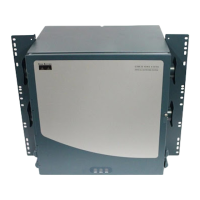14-4
Cisco ONS 15454 Procedure Guide, R5.0
December 2004
Chapter 14 Add and Remove Nodes
NTP-A212 Add a BLSR Node
• A CTC computer is directly connected to the new node.
• CTC computers are directly connected to other nodes on the same subnet.
If these conditions are present, add static routes on the node that will be added to the BLSR, using the
following settings:
• Destination IP address: IP-address-of-the-CTC-computer-connected-to-the-new-node
• Net Mask: 255.255.255.255
• Next Hop: IP-address-of-the-Cisco-ONS-15454
• Cost: 1
See the “DLP-A65 Create a Static Route” task on page 17-73. To view Gateway Settings, see the
“DLP-A249 Provision IP Settings” task on page 19-30.
Step 7 Complete the “DLP-A60 Log into CTC” task on page 17-66 at a node in the BLSR.
Step 8 Complete the “DLP-A298 Check the Network for Alarms and Conditions” task on page 19-63 to verify
that the BLSR is free of major alarms or problems. If trouble is indicated (for example, a major alarm
exists), resolve the problem before proceeding. See Chapter 7, “Manage Alarms” or, if necessary, refer
to the Cisco ONS 15454 Troubleshooting Guide.
Step 9 From the View menu, choose Go to Network View and click the Provisioning > BLSR tabs.
Step 10 On paper, record the Ring Name, Ring Type, Line Rate, Ring Reversion, and Span Reversion (4 Fiber).
Step 11 From the Nodes column, record the Node IDs in the BLSR. The Node IDs are the numbers in parentheses
next to the node name.
Step 12 Log into the new node:
• If the node has a LAN connection and appears on the network map, from the View menu, choose
Go to Other Node, then enter the new node.
• If the new node is not connected to the network, log into it using the “DLP-A60 Log into CTC” task
on page 17-66.
Step 13 Click the Alarms tab.
a. Verify that the alarm filter is not on. See the “DLP-A227 Disable Alarm Filtering” task on
page 19-17 as necessary.
b. Verify that no unexplained alarms appear on the network. If alarms appear, investigate and resolve
them before continuing. Refer to the Cisco ONS 15454 Troubleshooting Guide for procedures.
Step 14 Using the information recorded in Steps 10 and 11 and the diagram created in Step 1, create a BLSR on
the new node. See the “DLP-A242 Create a BLSR on a Single Node” task on page 19-23.
Step 15 (Optional.) Create test circuits, making sure they pass through the BLSR trunk cards and run test traffic
through the node to ensure the cards are functioning properly. See the “NTP-A295 Create a Manually
Routed OC-N Circuit” procedure on page 6-43 and the “NTP-A62 Test OC-N Circuits” procedure on
page 6-51 for information.
Step 16 Create the data communications channel (DCC) terminations on the new node. See the “DLP-A377
Provision Section DCC Terminations” task on page 20-61.
Note Creating the DCC terminations causes the SDCC Termination Failure and Loss of Signal alarms
to appear. These alarms remains active until you connect the node to the BLSR.

